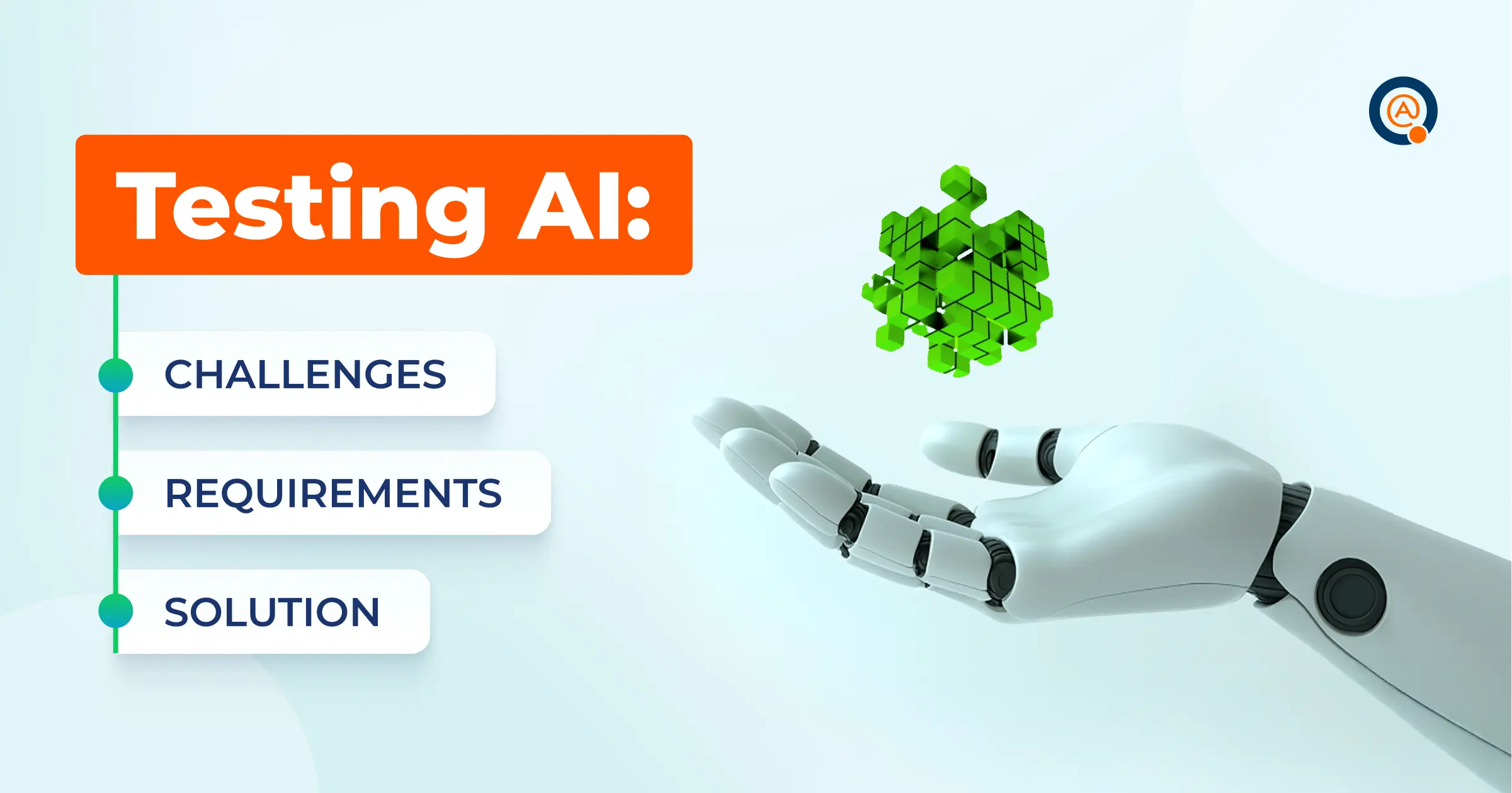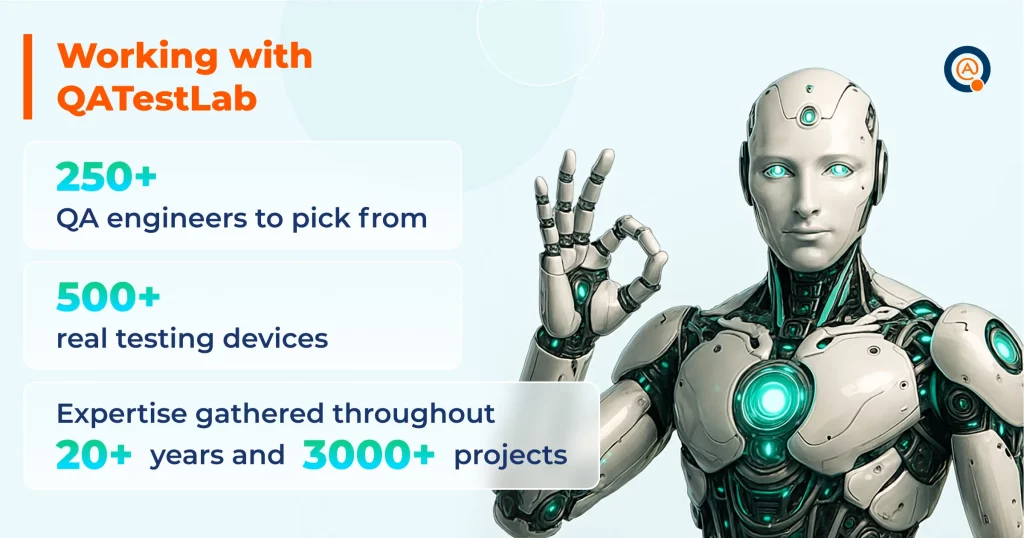- QATestLab Blog >
- QA Basics >
- Types of Software Testing >
- Testing AI >
- Quality Assurance for AI: Things You Need to Know
Quality Assurance for AI: Things You Need to Know

Artificial intelligence is not about the future anymore; it’s our day-to-day personal and business assistant. This directly impacts software. Gartner predicts that by 2028, agentic AI will be included in 33% of all enterprise apps.[1] Meanwhile, the 2024 DORA Report by Google Cloud shows that 89% of investigated organizations prioritize generative AI adoption.[2]
Customers also envision good use for AI. 93% of respondents in the recent Cisco research[3] believe that agentic AI will enable B2B vendors to deliver more predictive and proactive services. This rapid spread is driven by a clear promise: creating smarter, more personalized experiences. However, new tech always brings unprecedented quality challenges, especially when things move so fast. This caused many new QA methods to emerge, and our aim today is to help you make sense of it all.
What’s the Latest for Testing
The very nature of AI introduces new layers of risk and complexity – things to handle with testing. Though the list overall is pretty extensive, let’s go through the key quality challenges:
- The Black Box
AI models are often unpredictable and non-transparent in their internal logic, making it hard to foresee the output and understand the reasoning behind a faulty response. - Data Quality & Bias
AI is only as good as its training data. Insufficient, inaccurate, or biased data can lead to unfair, discriminatory, or simply incorrect outcomes. - Hallucinations
AI, especially large language models, can hallucinate – confidently generate false or nonsensical information. This makes it crucial to check the AI’s reasoning and output consistency through methods like chain-of-thought auditing. - The Oracle Problem
Test results are often verified through the so-called oracle – a correct output info to validate system behavior. However, there is no single correct answer with AI, making it a major challenge. - Model Degradation
As real-world data evolves, AI performance can degrade over time because the model’s original training data becomes irrelevant, a phenomenon also known as model drift. - Context & Long Sessions
In conversational AI, agents must maintain context over long, multi-turn interactions. This implies verifying the agent’s memory through multiple sequential queries and context accumulation.
To sustain the quality standards, AI software testing expands with more complex approaches that fit into the context of artificial intelligence and machine learning. But what about the classic methods? Are they still relevant?
Traditional QA – Does it Still Work?
Well, the “out with the old, in with the new” approach will definitely be rushed. Classic quality assurance still plays a foundational role, especially the human element. It becomes even more critical with the traits required for handling the complexities of AI software testing.

The creativity of manual and exploratory testing remains key for spotting edge cases and assessing nuanced usability. Beyond this, human review and oversight are essential in optimizing modern testing tools, especially ones with AI features. This includes refining AI-generated tests, validating security-critical paths, and applying critical thinking on a level AI couldn’t replicate.
Furthermore, quality doesn’t end on deployment. Continuous monitoring and efficient feedback loops prevent degradation. This includes tracking key production metrics like error frequency and data drift rate. Personal interpretation is crucial for proper analysis, and adding automated alerts also helps react in a timely manner when the critical thresholds are exceeded.
New: Using AI for Testing AI
The key to efficient AI testing is not choosing between traditional and emerging; it’s about integrating them into a composite strategy. This means enhancing time-tested QA practices with innovative, AI-driven QA techniques designed specifically for intelligent systems. Testing with AI should leverage emerging methods to cover all angles:
- Metamorphic Testing – helps verify system reliability without a predefined correct result by checking the relationships between multiple inputs and outputs.
- AI-Driven Evaluation – implies utilizing a secondary AI model designed to check the primary one for factual accuracy, bias, and linguistic consistency at scale.
- Real-time User Simulation – allows testing the application under more realistic circumstances by using LLMs as virtual users with specific personas.
- AI-Generated Test Cases – aimed to explore more paths and uncover blind spots by automatically generating test scenarios from requirements or user stories.
- Agent Logic Validation – confirms the agentic AI’s internal planning and reasoning to ensure it forms logical subtasks and correctly uses its built-in tools (API requests, search, file operations, etc).
Building AI-powered solutions is full of obstacles caused by the intricate nature of the technology. That is why it requires a creative view on quality that combines the latest testing tools and techniques with established QA expertise. What do you do when there’s no time to develop such skills internally?
Expertise for Testing AI
When it comes to specialized skills, we at QATestLab bridge that gap. Our AI testing service is based on a foundation of proven QA discipline combined with the most up-to-date AI-specific strategies.
Added the AI-based features to your established app? We’ll focus on integration and performance, tracking metrics like response availability, correctness, latency, and SLA. In contrast, testing a custom AI agent would require a deeper dive, measuring task completion rate, efficiency, time-to-complete, and resource usage (CPU, memory).
Here’s a quick case study overview for you to see what the partnership would look like. Basically, we worked with a mobile application featuring an AI chatbot designed to help users manage anxiety and stress. We fully focused on AI testing on this project, as the core function relied on the AI’s ability to provide emotionally safe replies.
The challenge was to ensure the AI would not produce emotionally harmful or unpredictable responses. Our AI testing strategy involved extensive exploratory testing to simulate high-risk scenarios and uncover unsafe replies. This was combined with rigorous functional testing of the chatbot logic and AI-based UI testing across a wide range of real iOS and Android devices. Our findings were crucial for refining the AI model, helping the client improve conversation handling and create a trustworthy user experience.
➥ Find the full service details in our AI Testing deck.

When testing AI solutions, we rely on four key pillars:
Proven QA Rigor
We approach AI with thoroughness honed by years of experience. From integration testing that verifies the connection and data transfer to testing boundary scenarios like empty or overlong prompts, we aim for maximum coverage. Whenever necessary, we’d also leverage automation for tasks like smoke and load tests for black-box AI or checking launch scenarios and logic changes for agentic AI.
A Proactive Focus on AI Risk
We aim to mitigate the unique risks associated with AI. This is done through targeted AI agent testing to uncover hidden biases, assess fairness, and identify security vulnerabilities. A key part of this is a risk-based approach, which includes verifying the UX and fallback mechanisms for when the AI service is unavailable or provides an incorrect response.
Tailored Expertise
Building an in-house team with the right skills for AI and machine learning based testing is a significant challenge. We provide flexible access to a large team of qualified QA engineers with specialized AI skills. Whether you need to augment your team or require a fully managed service, we provide the exact expertise needed to ensure consistent quality control.
Validation in Real-World Setup
An AI application’s performance can vary dramatically across different devices and platforms. We leverage our extensive device lab for AI-based software testing and comprehensive validation. By testing your AI application on 500+ real devices with diverse configurations, we ensure compatibility and flawless performance in your users’ hands.
Ensure Your AI is Ready for Users
The rise of AI is creating incredible opportunities, but it also raises the stakes for quality. A poorly tested AI can have major consequences, eroding user trust, introducing bias, and generating business risks. We are here to help you build reliable AI solutions that people will use to reach their goals.
We can start by detailing the project through Estimation or Audit. Ready? Share your context ➠ submit a form!

Sources
Learn more from QATestLab
Related Posts:
About Article Author
view more articles




